Scotland's Labour Market: People, Places, and Regions - Statistics from the Annual Population Survey 2019
Summary publication of results from the Annual Population Survey 2019, presenting analysis on the labour market, education and training.
This document is part of a collection
Section 2: Type of Work
2.1 Type of Employment
In 2019, 1,957,000 people were in full-time employment and 703,900 people were in part-time employment.
Since 2009, the levels of part-time and full-time employment for women have increased. For men, levels of part-time employment have increased, and that for full-time employment is marginally higher than in 2009.
Part-time working accounts for a similar share of employment compared with 2009, increasing from one quarter (25.9 per cent) in 2009 to 26.5 per cent in 2019.
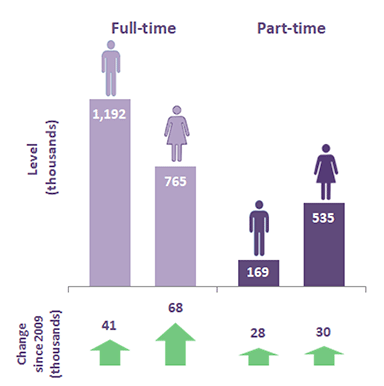
Part-time employment accounts for 41.2 per cent of all women's employment compared with 12.4 per cent of all men's employment.
Part-time employment is also more common for those in employment aged 16 to 24 years (39.6 per cent), with the majority being students, and for those aged 65 years and over where 62.0 per cent were working part-time.
Secure employees
In 2019, 96.5 per cent of employees (18 years+) were securely employed, where they held a permanent job or their jobs was temporary and they did not want a permanent job. 80,900 people were in employment which was not secure.
As a percentage of all employees by age band, young people (18 to 24) were least likely to be securely employed.
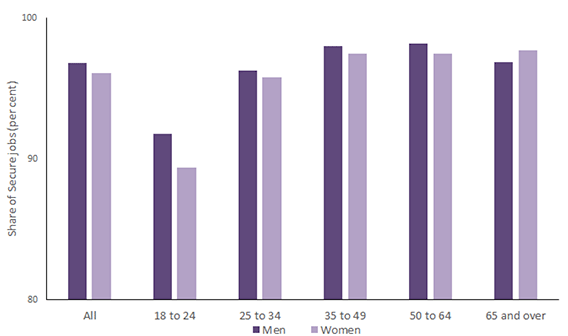
Self-employment
329,600 people in employment were self-employed in Scotland, this is the highest since the series began in 2004.
Self-employment accounted for 12.4 per cent of all employment in Scotland in 2019. This remains below the UK where 15.3 per cent of those in employment are self-employed.
Women accounted for an increasing share of self-employment from 26.8 per cent in 2004 to 35.5 per cent in 2019. The number of women who are self-employed increased steadily from 66,200 in 2004 to 116,900 in 2019.
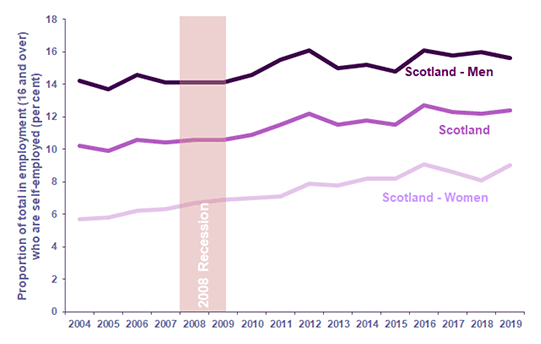
The number of men in Scotland who are self-employed increased from 181,000 in 2004 to 212,700 in 2019, slightly less than 2018 when 218,400 were self-employed.
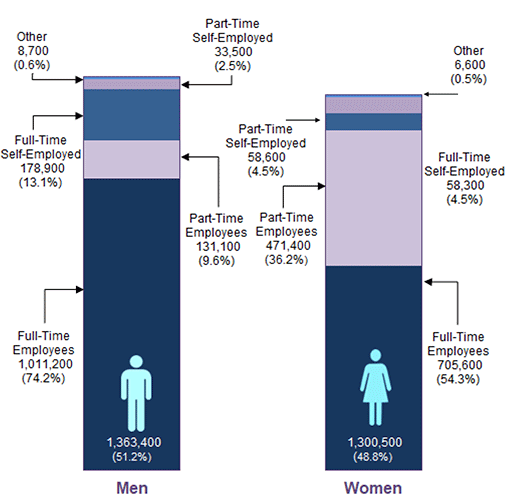
* A small number of respondents who were unable to report whether they were full-time or part-time have been excluded.
2.2 Underemployment
What is underemployment?
Underemployment refers to those who are in work but who would prefer to work more hours for the same rate of pay and provides a measure of underutilisation of labour.
The APS only collects information on hours based underemployment.
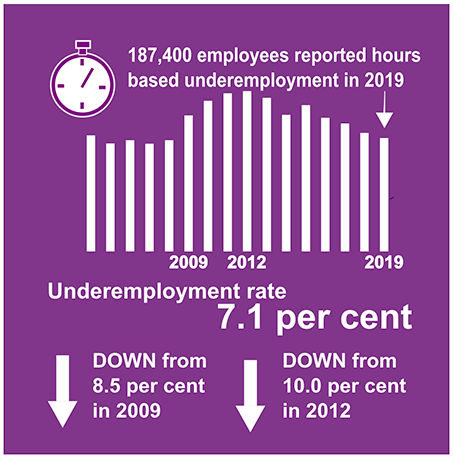
In 2019, 187,400 employees were underemployed in Scotland, the lowest level and rate since 2008.
Underemployment was higher for women (7.5 per cent) compared with men (6.7 per cent).
Underemployment decreased from 7.4 per cent in 2018 to 7.1 per cent in 2019 and continues to be significantly lower than the peak rate of 10.0 per cent in 2012*. Men's underemployment fell from its peak of 9.0 per cent in 2013 to 6.7 per cent in 2019* and women's underemployment fell from its peak of 11.6 per cent in 2012 to 7.5 per cent in 2019*.
By age, underemployment is highest amongst employees aged 16 to 24 years and at 16.6 per cent is over double the national average. In the period since 2012, underemployment has decreased across all age bands*.
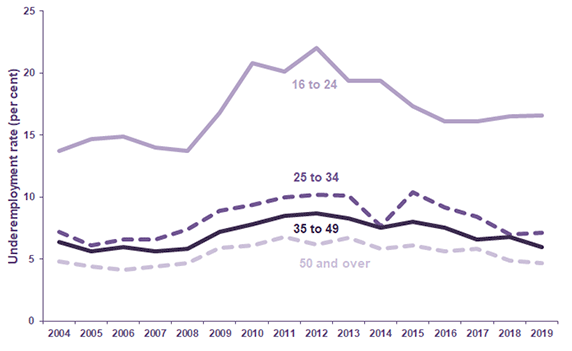
Underemployment rate (underemployment as a percentage of all employees) has consistently been highest amongst men working part-time (25.5 per cent), followed by women working part-time (12.9 per cent) and lowest amongst women working full-time (3.8 per cent) and men working full-time (4.1 per cent).
The largest decrease in underemployment over the last seven years, by gender and work pattern, was for men working part-time. In 2013, 33.9 per cent reported being underemployed, reducing to (25.5 per cent) in 2019*.
Regional Variation
There is regional variation in the underemployment rate. However, data are not available** for: Clackmannanshire, Highland, Orkney Islands, Shetland Islands, South Lanarkshire, and West Lothian.
The lowest rates were in:
- North Lanarkshire (4.4 per cent);
- East Dunbartonshire (4.6 per cent); and,
- East Ayrshire (5.3 per cent).
The highest rates in 2019 were in:
- Na h-Eileanan Siar (11.3 per cent),
- Angus (9.6 per cent) and
- Dundee City (9.5 per cent).
In the last year, for the 26 local authorities where data are robust, the rate of underemployment has decreased in 10 local authorities and increased in 13 local authorities and remained unchanged in 3.
The largest decreases were in:
- North Ayrshire down by 5.3 percentage points to 7.9 per cent*;
- South Ayrshire down by 3.8 percentage points to 6.4 per cent*.
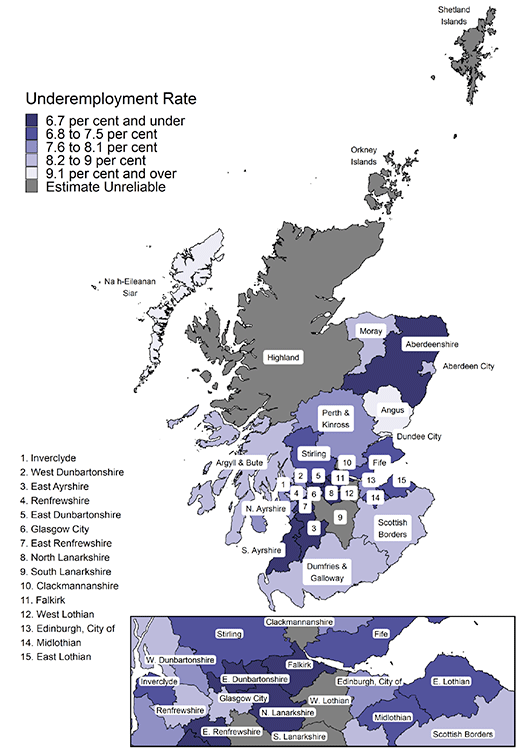
* Statistically Significant.
** Estimates are below reliability threshold or disclosive.
2.3 Employment by Sector
Public Sector Employment accounts for 26.2 per cent of all in employment while private sector employment is 73.8 per cent of all in employment.
The local authorities with the highest public sector employment estimates were:
- East Renfrewshire (33.6 per cent);
- West Dunbartonshire (31.4 per cent); and.
- South Ayrshire (30.2 per cent).
The official measure of public sector employment is the SG Quarterly Public Sector Survey. Estimates of employment by sector on the APS are based on self-report.
In the last 10 years, there have been substantial movements in the number of people employed by sector. The largest increases for employment by gender are within the "Public Administration and Defence", and "Health and Social Work" sectors with 41,000 more women employed in these sectors. (Note this is not the same as the Public Sector).
Otherwise, larger changes saw more women employed in: "Professional, Scientific and Technical Activities" occupations (increasing 18,000), and "Other Service Activities" (increasing 16,000).
While for men increases were seen in: "Financial and Insurance Activities" (increasing 17,000), "Accommodation and Food Services" "Information and Communication" and "Mining and Quarrying" (all increasing by 14,000).
Employment for men decreased for: "Agriculture, Forestry and Fishing" (decreasing 10,000), "Manufacturing" (decreasing 7,000) and "Construction" (decreasing 6,000).
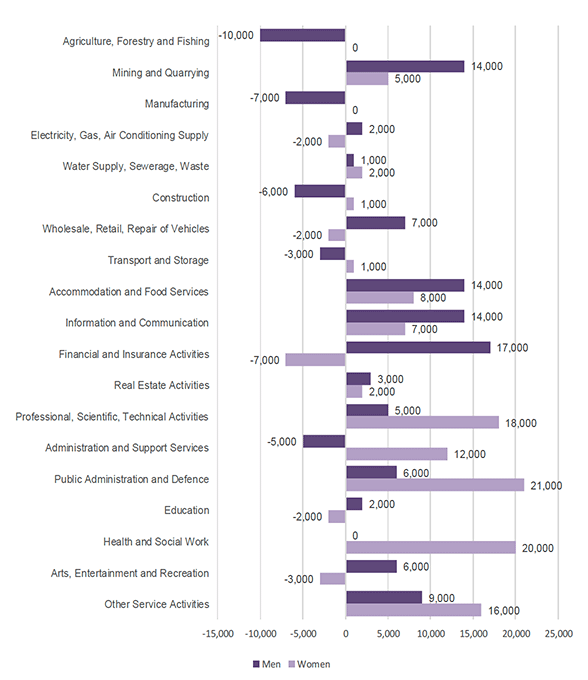
2.4 Occupational Skills
Between 2004 and 2019, there has been a gradual increase in the employment levels in high skilled occupations (e.g. functional management in finance, marketing, public finance, etc.) and medium-high skill occupations (e.g. health associate professional, nursing, etc.).
Employment in high skill occupations increased by 22.0 per cent between 2009 and 2019, increasing from 600,500 to 732,800 while medium-high skilled occupations increased by 8.7 per cent from 677,500 to 736,600 over the same period.
High and medium-high skill occupations account for 55.2 per cent of all jobs in 2019.
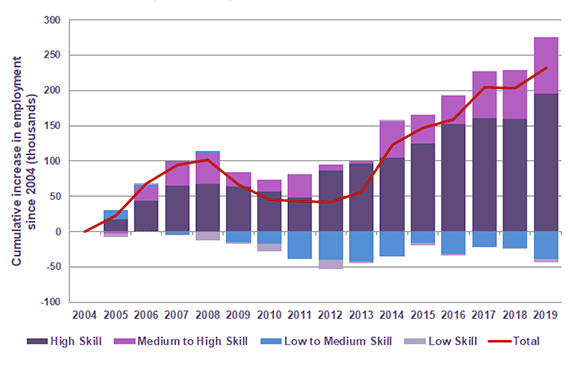
This compares with a decline in employment in medium-low and low skill (e.g. sales assistant, retail cashier) .Employment in medium-low skilled occupations decreased by 2.6 per cent between 2009 and 2019, decreasing from 925,700 to 901,700. Low skill occupations (e.g. bar staff, cleaning, etc.) also declined in this period by 0.5 per cent from 289,500 to 288,000. 44.7 per cent of jobs are low skill or medium-low skills.
Low skill or medium-low skills jobs are proportionately higher in "Transport and Storage" (75.1 per cent), "Wholesale, Retail, Repair of Vehicles" (71.3 per cent), "Administration and Support Services" (66.6 per cent).
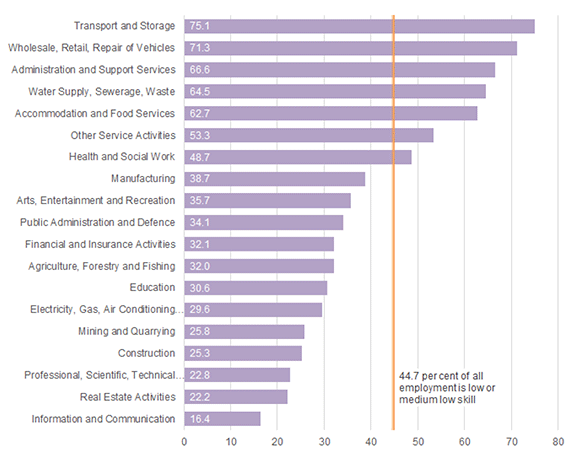
2.5 Gender Segregation
Gender segregation remains a persistent issue across several broad industry sectors and occupational groups in Scotland.
Although equality legislation has been in place for many years, gender segregation is still apparent in many industry sectors in Scotland.
Almost half of women in Scotland (46.2 per cent) work in the "Public Administration and Defence", "Education", and "Health and Social Work" sectors (Note this is not the same as the Public Sector). (Sectors with high levels of gender segregation towards women).
Just under half (43.5 per cent) of men work in sectors that show high levels of gender segregation: "Construction" (12.3 per cent), "Manufacturing" (11.8 per cent), "Transport, Storage & Information" (11.0 per cent), energy and water (6.2 per cent) and "Agriculture, Forestry and Fishing" (2.2 per cent).
Gender segregation across the various occupational groups show a similar picture to that seen across industry sectors with specific occupational groups showing high levels of segregation.
42.3 per cent of women in Scotland were employed in occupations that are gender segregated towards women: "Administrative and Secretarial" (14.5 per cent), "Personal Service Occupations" (16.8 per cent), and "Sales and Customer Service Occupations" (11.0 per cent).
30.0 per cent of men in Scotland were employed in occupations that exhibit high levels of gender segregation towards men: "Skilled Trades Occupations" (19.3 per cent) and "Process, Plant and Machine Operatives" (10.7 per cent).
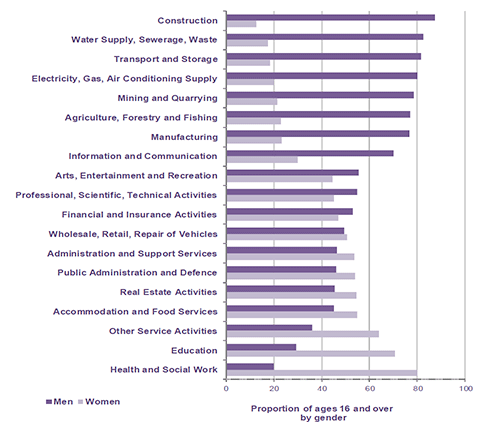
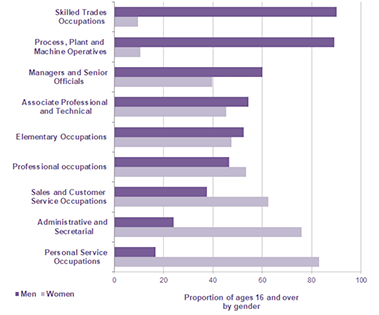
2.6 Job Related Training
National Performance Framework Indicator
Work place learning
The percentage of employees who reported receiving job related training in the last 3 months has been decreasing over time. In 2009, slightly over a quarter of workers (27.6 per cent) received job related training in the last 3 months, decreasing to 23.7 per cent in 2019*.
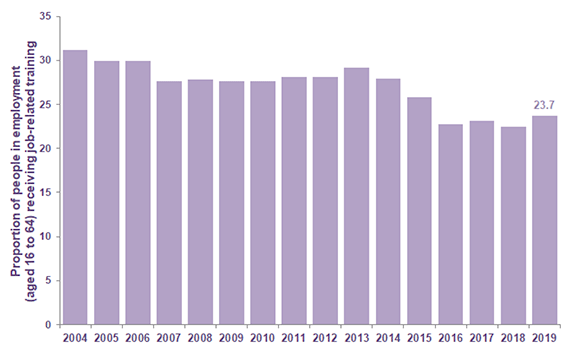
The highest proportion of employees aged 16 to 64 years old who reported receiving job related training was seen in**:
- Angus (33.5 per cent);
- Dundee City (31.7 per cent); and,
- North Ayrshire (31.2 per cent).
While the lowest proportion of employees aged 16 to 64 years old who reported receiving job related training was seen in**:
- Scottish Borders (12.7 per cent);
- Clackmannanshire (14.6 per cent); and,
- Falkirk (14.4 per cent).
Since 2009, across Scotland, the largest decreases were seen in:
- Fife down by 12.21* percentage points to 22.5 per cent;
- Scottish Borders down 12.21* percentage points to 12.7 per cent; and,
- Argyll and Bute down by 12.01* percentage points to 21.4 per cent.
In the last year, the proportion of employees aged 16 to 64 years old who reported receiving job related training has increased slightly from 22.5 per cent to 23.7 per cent in 2019.
Across Scotland, the proportion increased in 21 local authorities. The largest increases were seen in:
- Renfrewshire up by 11.71* percentage points to 29.1 per cent;
- Midlothian up by 9.61* percentage points to 30.8 per cent; and,
- Moray up by 7.11* percentage points to 25.9 per cent.
* Statistically Significant
** Data not available for Orkney Islands and Shetland Islands
Contact
Email: LMStats@gov.scot
There is a problem
Thanks for your feedback